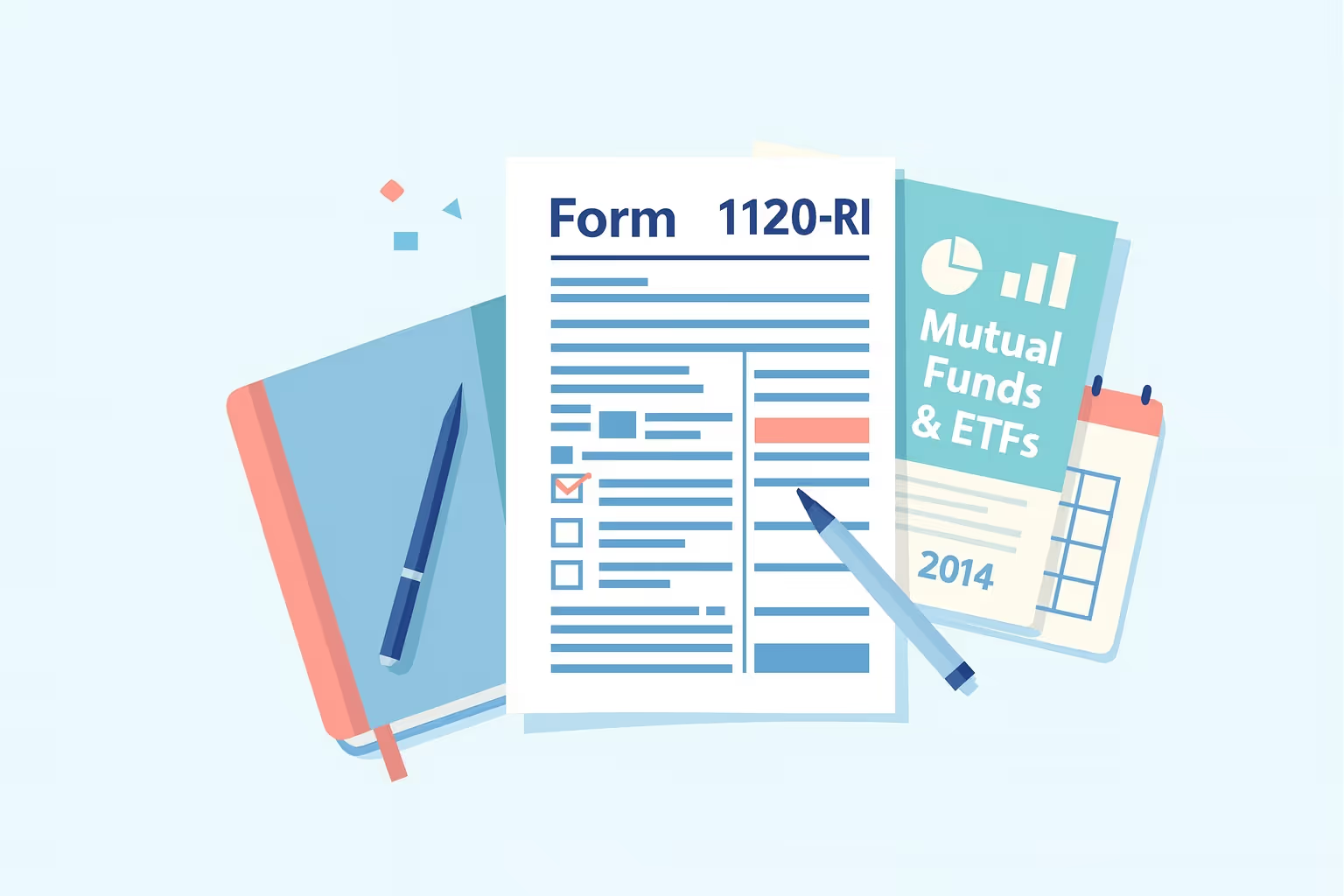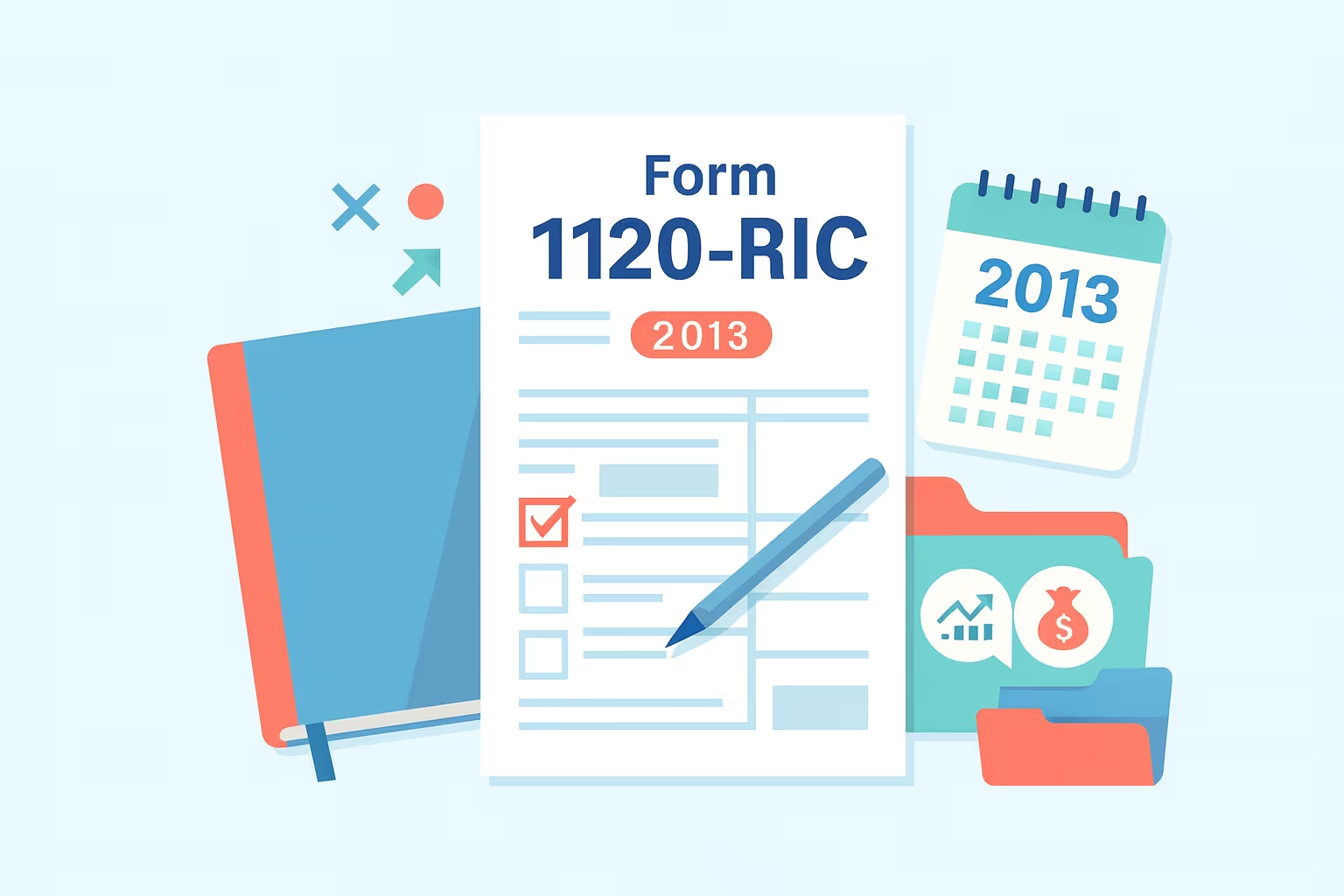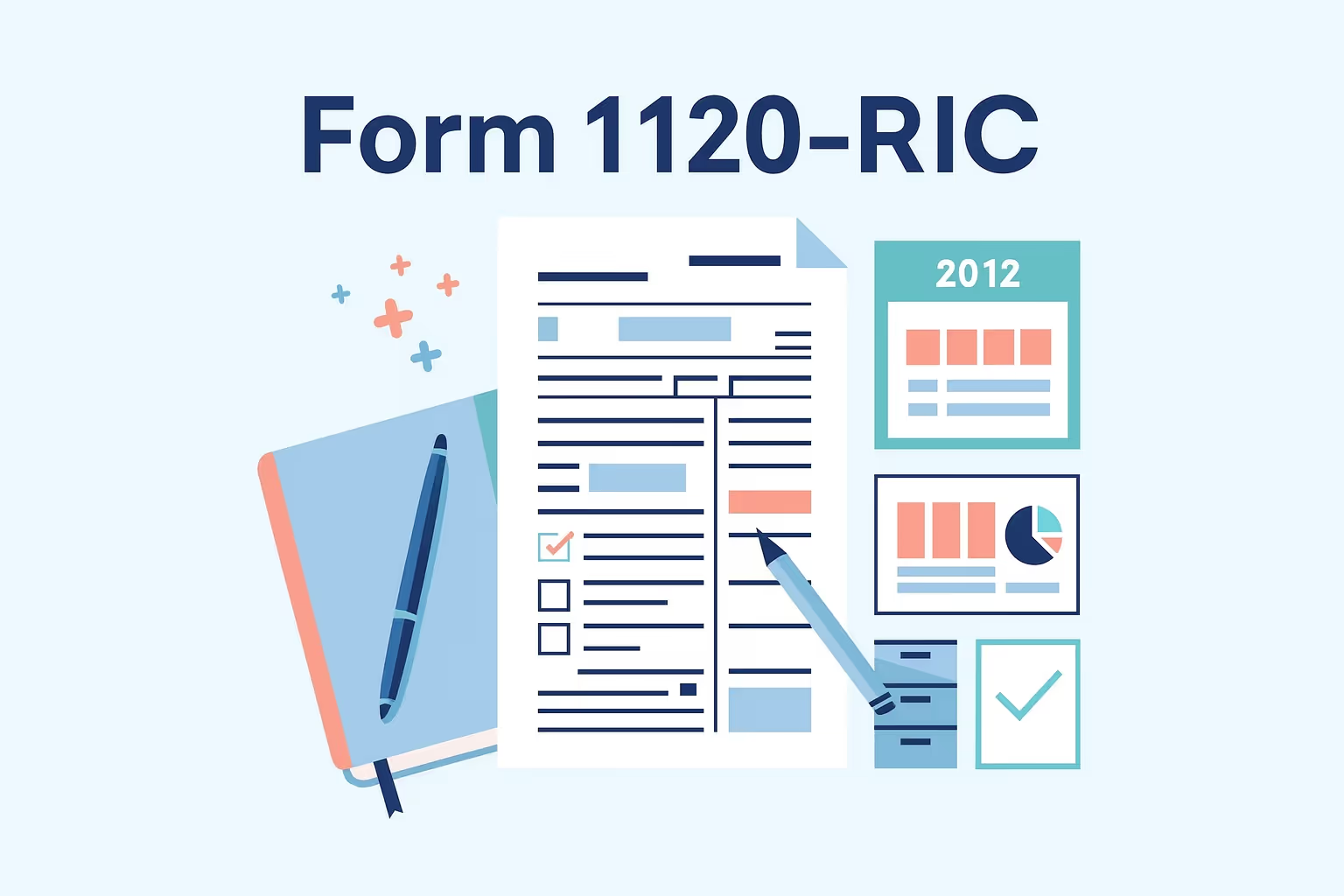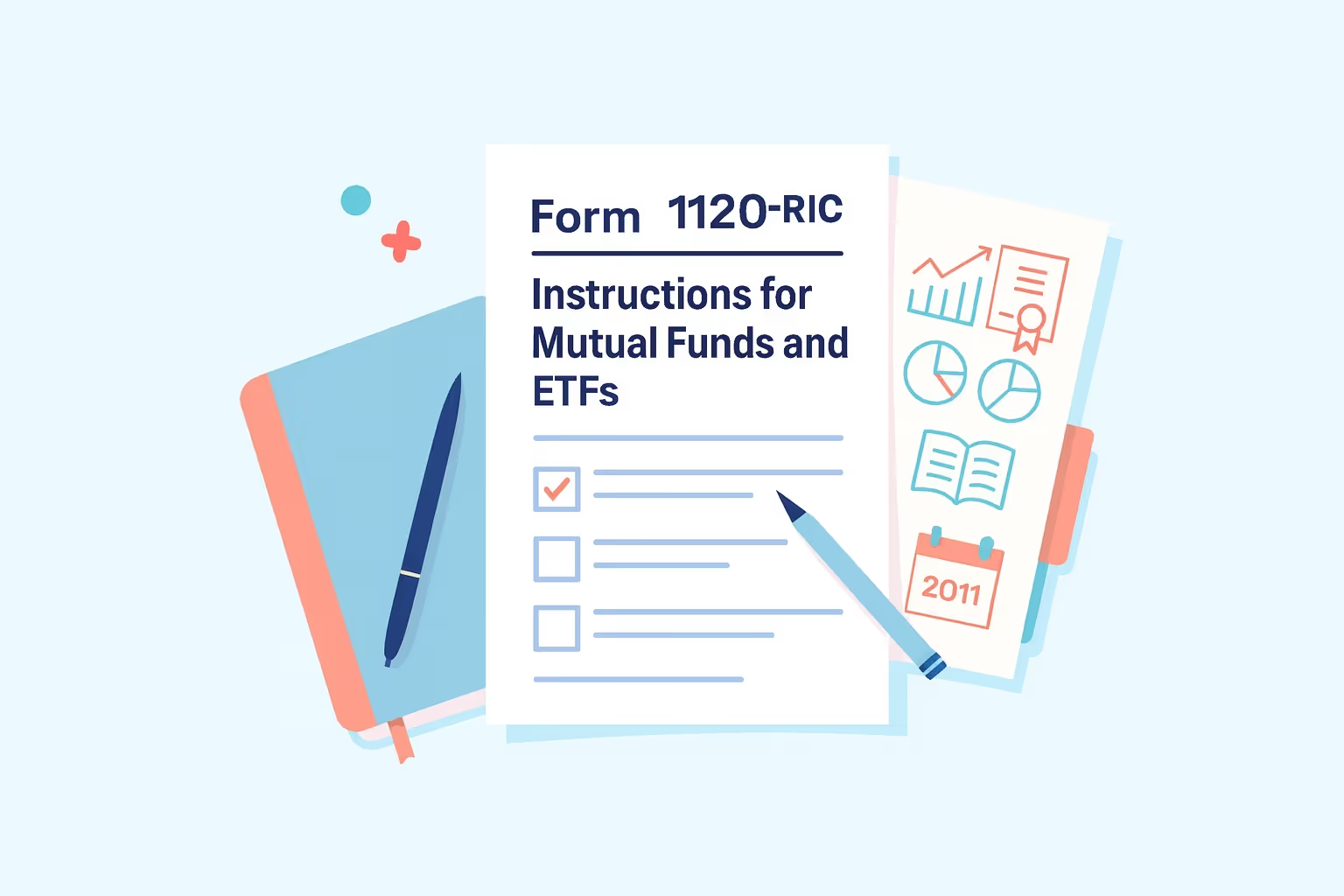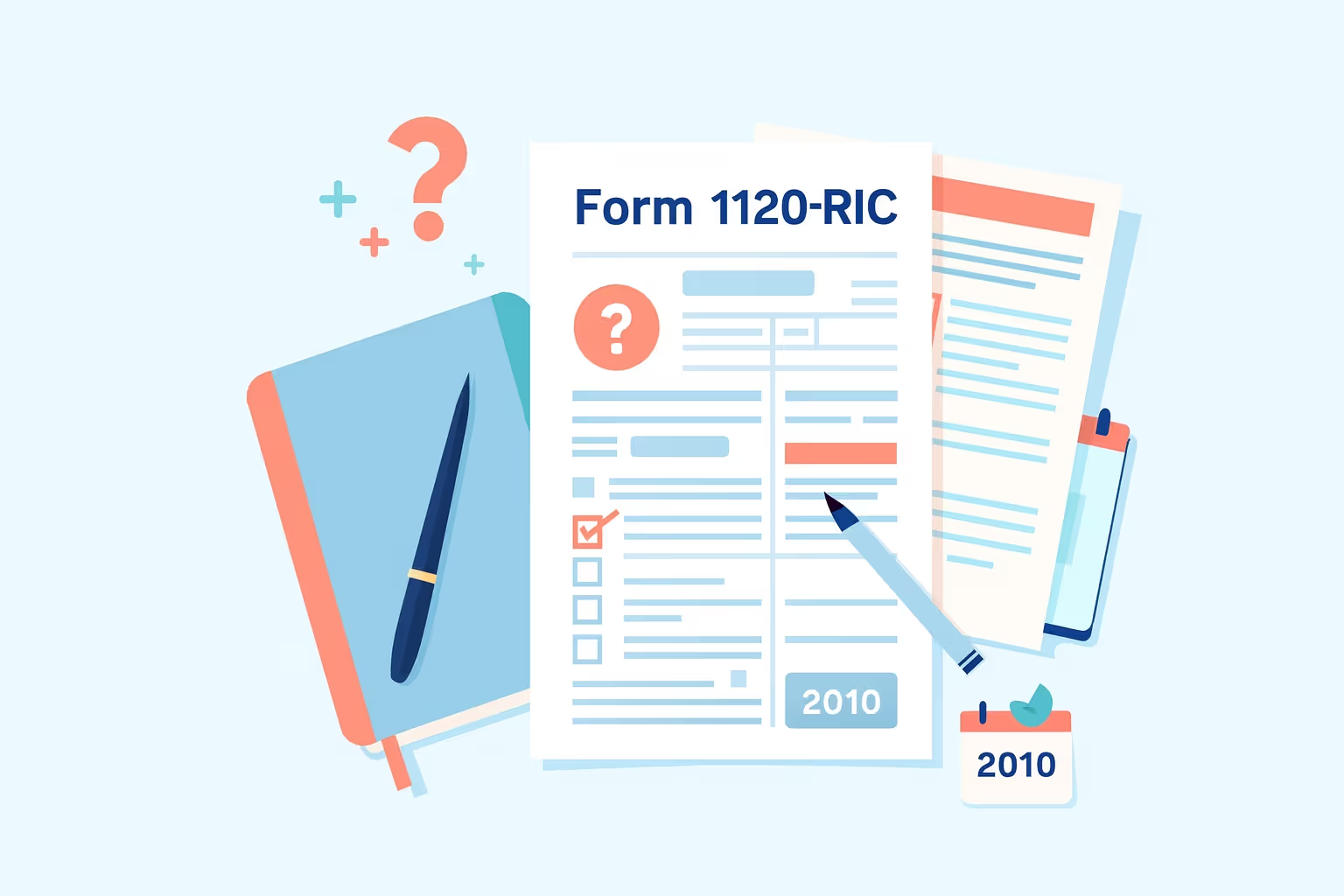
In 2023, the Internal Revenue Service processed more than 260 million tax returns, but thousands of regulated investment companies were penalized for late or inaccurate filings. The reality is apparent: filing Federal Form 1120-RIC for Tax Year 2023 is not optional for mutual funds and other investment companies that qualify as regulated investment companies. Missing deadlines or submitting the wrong information can result in penalties, lost deductions, and higher tax liability.
Federal Form 1120-RIC is a regulated investment company's corporation income tax return. These entities only receive favorable tax treatment under the Internal Revenue Code if they meet strict filing and reporting requirements. Proper filing allows companies to avoid double taxation by passing most of their taxable income to shareholders. Errors or delays, however, can strip away these benefits and subject the company to regular corporate tax rates.
This guide will walk you through completing and filing Federal Form 1120-RIC for Tax Year 2023. You will learn how to handle filing requirements, respond to recent tax law changes, calculate taxable income, and meet distribution rules. We will also explain estimated tax payments, payment systems, and common filing mistakes. By following these steps, your investment company can reduce the risk of penalties and maintain compliance with federal tax laws.
Understanding Federal Form 1120-RIC
Before beginning the filing process, it is essential to understand Federal Form 1120-RIC, who must file it, and how it differs from other corporate income tax returns. This foundation helps ensure regulated investment companies remain compliant for federal tax purposes.
What is Federal Form 1120-RIC?
Federal Form 1120-RIC is the corporation income tax return that regulated investment companies (RICs) use. These include mutual funds, exchange-traded funds, and other investment companies that elect RIC status under the Internal Revenue Code. Filing this form allows RICs to report taxable income, capital gains, deductions, and credits while avoiding double taxation. Instead of paying tax on net income at the corporate level, RICs pass most of their taxable income through to shareholders, provided they meet distribution and qualification rules.
Who Must File: Domestic Corporations vs. Foreign Corporations
Domestic corporations must file Federal Form 1120-RIC if they are registered investment companies under the Investment Company Act of 1940 or have elected to be treated as a RIC for federal tax purposes.
Foreign corporations with U.S. investment activities may also need to file if they meet specific IRS rules. Real estate investment trusts (REITs) file a different form, while S corporations and C corporations use their standard corporation income tax returns. Distinguishing between these entities is critical to avoid using the incorrect form.
Comparison: Form 1120, Form 1120-RIC, and Form 1120-S
To clarify filing requirements, it helps to compare the most common corporate returns:
Comparison of Corporate Tax Forms
1. Form 1120
- Filed By: C corporations
- Purpose: Reports business income, deductions, and credits
- Tax Treatment: Subject to corporate tax rates
2. Form 1120-RIC
- Filed By: Regulated investment companies
- Purpose: Reports investment income, capital gains, and distributions
- Tax Treatment: Eligible for pass-through treatment if requirements are met
3. Form 1120-S
- Filed By: S corporations
- Purpose: Reports shareholders’ share of income and losses
- Tax Treatment: Income is passed through to shareholders
This comparison highlights why investment companies must use Federal Form 1120-RIC for Tax Year 2023: it ensures compliance with federal tax law while preserving favorable pass-through treatment.
Key Tax Law Changes for Tax Year 2023
For tax years beginning in 2023, the Internal Revenue Service introduced several changes directly affecting regulated investment companies filing Federal Form 1120-RIC. Staying current with these tax law changes is essential to avoid penalties and reporting errors.
Penalty Updates
The minimum late filing penalty has increased to $485 for returns filed more than 60 days after the due date. This penalty applies even if your RIC owes no tax. The IRS continues to apply interest and additional monthly charges for late tax payment shown on the return. Missing the deadline can quickly increase total tax liability.
Business Meals Deduction
The temporary 100% deduction for business meals has expired. For tax year 2023, investment companies must return to the standard 50% meal deduction. Claiming more than allowed may lead to disallowed deductions and potential amended returns.
Elective Payment Election
RICs may now treat certain general business credits as elective payments under Form 3800. This option can result in refunds rather than credits carried forward. However, it requires careful review of form instructions to avoid calculation errors that could affect taxable income.
Comparison: Tax Law Changes 2022 vs. 2023
Late Filing Penalty
- 2022: $435 minimum
- 2023: $485 minimum
Business Meals Deduction
- 2022: 100% deductible from restaurant expenses
- 2023: Limited to 50% deduction
Credit Options
- 2022: Credits could be carried forward or used to offset tax
- 2023: Elective payment election is now available
Understanding these differences helps regulated investment companies avoid incorrect form entries and comply with federal tax purposes.
Filing Requirements and Documentation
After reviewing the 2023 updates, the next step is confirming filing requirements and gathering the correct documentation. Regulated investment companies that do not meet qualification standards risk losing their RIC election and being taxed as a regular C corporation.
Filing Requirements for RICs
A company must satisfy three major tests under the Internal Revenue Code to qualify as a regulated investment company:
- Income Test: At least 90% of gross income must come from dividends, interest, or gains on securities. If this requirement is unmet, the company will lose its eligibility for RIC treatment.
- Asset Test: At least 50% of total assets must be diversified among cash, government securities, or securities of other issuers with strict limits. The company may be taxed under standard corporation income tax return rules if these limits are breached.
- Distribution Test: At least 90% of the investment company's taxable income must be distributed to shareholders. Failure to meet this requirement results in double taxation on undistributed net income.
Required Documents Checklist
Gathering proper records ensures smooth filing. The following items are essential for preparing Federal Form 1120-RIC for Tax Year 2023:
- Investment Income Statements: These statements must include dividends, interest, and capital gains, and they should align with shareholder reporting to avoid discrepancies.
- Capital Gains and Loss Reports: Detailed records of realized and unrealized gains must be kept to support Schedule D entries and reconcile with Form 2438 when applicable.
- Asset Valuation Reports: Quarterly valuations must be prepared to confirm compliance with the 50% and 25% asset tests. Missing documentation can put RIC status at risk.
- Foreign Tax Credit Records: Documentation for any tax credit claimed for payments to a foreign country must be supported by schedules consistent with forms such as Form 1118 or Form 8621.
- Dividend and Distribution Records: Records must clearly show shareholders’ share of distributions, as this evidence proves compliance with the 90% distribution test.
Filing Deadlines and Extensions
Most RICs operate on a calendar year, with the due date being April 15 of the following year. If the date falls on a weekend or holiday, the due date shifts to the next business day. Companies can request a six-month extension by filing Form 7004, but any tax shown as owed must still be paid by the original deadline—failure to pay results in late payment penalties and late filing penalties.
Step-by-Step Instructions for Filing Federal Form 1120-RIC
With your documents gathered, you can now move into the filing process. Federal Form 1120-RIC for Tax Year 2023 is structured into different parts, each requiring accuracy to ensure compliance with federal tax law. A straightforward step-by-step approach will help prevent mistakes and reduce the risk of penalties.
Step 1: Complete Income and Deductions
- Part I – Income: Enter all investment income, including dividends, interest, capital gains, and other qualifying income. To avoid mismatched records, the totals must be reconciled with supporting schedules and shareholder reports.
- Part II – Deductions: Report deductions such as interest, business expenses, bad debts, and experimental expenditures. Deduction claims must reflect actual costs and not include disallowed items such as 100% meal expenses for 2023.
- Special Deductions: If eligible, apply special deductions under the Internal Revenue Code. These may include dividends-received deductions or other limited deductions applicable to certain regulated investment companies.
Step 2: Calculate Tax Computation
- Part III – Tax Computation: Use Schedule J to compute total tax liability. This includes corporate income tax, alternative minimum tax if applicable, and adjustments for credits or payments already made.
- Net Operating Loss (NOL): Apply any NOL carryforwards allowed under federal tax purposes. Documentation must explain how the NOL was calculated and carried forward from prior-year returns.
- Tax Shown on the Return: Ensure the tax shown reflects accurate calculations. Errors here can result in notices from the Internal Revenue Service and potential amended returns.
Step 3: Report Other Information and Attach Required Schedules
- Schedule K – Other Information: Answer questions about the company’s structure, ownership, and elections. This section requires disclosing international operations, shareholder information, and accounting methods.
- Schedule L – Balance Sheets per Books: Present the beginning and ending balances for assets, liabilities, and equity. These entries must match audited or internally maintained financial statements.
- Schedule M-1 – Reconciliation: Reconcile book income with taxable income. This ensures that differences between accounting records and tax treatment are explained clearly.
- Supporting Schedules: Attach all required supporting schedules in the correct order. The IRS requires schedules to be organized numerically or alphabetically, followed by statements as necessary.
Step 4: Meet Distribution Requirements
- The 90% Rule: A regulated investment company must distribute at least 90% of its investment company taxable income to shareholders. If this threshold is not met, the company will lose its RIC status and face taxation as a C corporation.
- Excise Tax Requirements: Besides the 90% rule, RICs must meet excise tax distribution requirements. If distributions fall short, Form 8613 must be filed, and the company must pay a 4% excise tax on the undistributed income.
- Timing of Distributions: Distributions declared in the last quarter of the year and paid in January may count toward the prior year. Companies must carefully document these payments to avoid disputes with the IRS.
By following these steps carefully, regulated investment companies can confidently complete Federal Form 1120-RIC for Tax Year 2023. Accuracy in each section ensures compliance and protects the company from avoidable penalties and the loss of favorable tax treatment.
Step-by-Step Instructions for Filing Federal Form 1120-RIC
With your documents gathered, you can now move into the filing process. Federal Form 1120-RIC for Tax Year 2023 is structured into different parts, each requiring accuracy to ensure compliance with federal tax law. A straightforward step-by-step approach will help prevent mistakes and reduce the risk of penalties.
Step 1: Complete Income and Deductions
- Part I—Income: Enter all investment income, including dividends, interest, capital gains, and any other qualifying income. The totals must be reconciled with supporting schedules and shareholder reports to avoid mismatched records.
- Part II – Deductions: Report deductions such as interest, business expenses, bad debts, and experimental expenditures. Deduction claims must reflect actual costs and not include disallowed items such as 100% meal expenses for 2023.
- Special Deductions: If eligible, apply special deductions under the Internal Revenue Code. These may include dividends-received deductions or other limited deductions applicable to certain regulated investment companies.
Step 2: Calculate Tax Computation
- Part III – Tax Computation: Use Schedule J to compute total tax liability. This includes corporate income tax, alternative minimum tax if applicable, and adjustments for credits or payments already made.
- Net Operating Loss (NOL): Apply any NOL carryforwards allowed under federal tax purposes. Documentation must explain how the NOL was calculated and carried forward from prior-year returns.
- Tax Shown on the Return: Ensure the tax shown reflects accurate calculations. Errors here can result in notices from the Internal Revenue Service and potential amended returns.
Step 3: Report Other Information and Attach Required Schedules
- Schedule K – Other Information: Answer questions about the company’s structure, ownership, and elections. This section requires disclosing international operations, shareholder information, and accounting methods.
- Schedule L – Balance Sheets per Books: Present the beginning and ending balances for assets, liabilities, and equity. These entries must match audited or internally maintained financial statements.
- Schedule M-1 – Reconciliation: Reconcile book income with taxable income. This ensures that differences between accounting records and tax treatment are explained clearly.
- Supporting Schedules: Attach all required supporting schedules in the correct order. The IRS requires schedules to be organized numerically or alphabetically, followed by statements as necessary.
Step 4: Meet Distribution Requirements
- The 90% Rule: A regulated investment company must distribute at least 90% of its investment company taxable income to shareholders. If this threshold is not met, the company will lose its RIC status and face taxation as a C corporation.
- Excise Tax Requirements: Besides the 90% rule, RICs must meet excise tax distribution requirements. If distributions fall short, Form 8613 must be filed, and the company must pay a 4% excise tax on the undistributed income.
- Timing of Distributions: Distributions declared in the last quarter of the year and paid in January may count toward the prior year. Companies must carefully document these payments to avoid disputes with the IRS.
By following these steps carefully, regulated investment companies can confidently complete Federal Form 1120-RIC for Tax Year 2023. Accuracy in each section ensures compliance and protects the company from avoidable penalties and the loss of favorable tax treatment.
Filing Methods: E-file vs. Paper
After completing Federal Form 1120-RIC for Tax Year 2023, the next step is deciding how to file. The Internal Revenue Service accepts electronic and paper filings, but each method has its own requirements.
Electronic Filing Advantages
Electronic filing is the recommended method for most corporations. It provides immediate confirmation of receipt, reduces the chance of errors, and typically results in faster processing by the IRS. Large corporations with $10 million or more in total assets, or those required to file Schedule M-3, must file electronically. This method simplifies compliance because electronic forms automatically guide taxpayers through the correct form entries.
Paper Filing Procedures
Paper filing is still permitted for corporations and is not subject to mandatory e-file rules. Completed returns must be mailed to the proper IRS processing center based on the company’s principal place of business. For corporations in the eastern United States, returns are sent to Kansas City, Missouri, while corporations in the western states send theirs to Ogden, Utah. Filing from a foreign country requires sending the return to the address listed in the current IRS form instructions. Incorrect mailing addresses often result in delays and late filing penalties.
Required Signatures and Paid Preparer Rules
An authorized corporate officer, such as the president, vice president, or treasurer, must sign the return. If a paid preparer completes the form, that individual must also sign and provide identifying information. Legal services or accounting firms serving as paid preparers must ensure their information is appropriately disclosed, since the IRS considers unsigned or incomplete returns invalid.
Tax Payments and EFTPS
Filing Federal Form 1120-RIC for Tax Year 2023 is only part of the process. Regulated investment companies must also make payments correctly and on time. The Internal Revenue Service requires electronic deposits for nearly all corporate tax obligations, including income, estimated, and excise taxes.
Electronic Federal Tax Payment System (EFTPS)
The Electronic Federal Tax Payment System (EFTPS) is mandatory for business entities filing corporation income tax returns. Enrollment requires the company’s employer identification number, banking details, and verification through a PIN sent by mail.
Once activated, EFTPS allows secure payment scheduling and provides a confirmation number for every transaction. Corporations that attempt to pay with paper checks or money orders instead of EFTPS risk rejected payments and penalties.
Estimated Tax Payments
If a regulated investment company expects to owe $500 or more in tax shown on its federal return, it must make quarterly estimated tax payments. These installments are due on the 15th day of the 4th, 6th, 9th, and 12th months of the tax year for calendar year filers.
Missing a payment deadline can trigger penalties, even if the final tax liability is paid by the due date. Accurate estimated tax payment calculations are crucial to avoid interest charges on underpaid amounts.
Late Payment Penalties and Interest
Failure to pay taxes by the original due date results in a penalty equal to 0.5% of the unpaid balance per month, up to 25% of the total tax. Interest accrues daily on unpaid amounts until full payment is received. The IRS enforces these penalties strictly, meaning that even corporations granted a filing extension under Form 7004 must still meet payment deadlines to avoid additional charges.
Common Mistakes to Avoid
Even well-prepared corporations make mistakes when filing Federal Form 1120-RIC for Tax Year 2023. These errors often result in penalties, processing delays, or even the loss of RIC status. By identifying common issues in advance, investment companies can avoid costly consequences.
Qualification Failures
- Income and Asset Tests: Some companies fail to meet the 90% income test or the asset diversification requirements at quarter-end. When these standards are not met, the company risks being taxed as a regular C corporation instead of enjoying pass-through treatment.
- Distribution Test: A frequent mistake is not distributing at least 90% of the investment company's taxable income to shareholders. This oversight results in double taxation and a loss of favorable tax treatment.
Filing Errors
- Incorrect Form Usage: Several companies mistakenly file Form 1120 instead of Federal Form 1120-RIC. Filing the wrong form causes delays, amended returns, and possible penalties.
- Missing or Incomplete Supporting Schedules: Failing to include required schedules such as Schedule J, Schedule K, or supporting statements can lead to processing issues. Every entry must be supported by documentation to avoid IRS correspondence.
Payment Errors
- Failure to Use EFTPS: The IRS requires electronic payments, yet some corporations still attempt to send paper checks or money orders payable to the Treasury. These payments are not accepted and can result in late payment penalties.
- Underpayment of Estimated Tax: Corporations that fail to calculate and submit accurate estimated tax payments face penalties, even if the final balance is later paid in full.
Avoiding these mistakes is essential for preserving regulated investment company status and ensuring smooth compliance with federal tax purposes.
FAQs
When is the due date for Federal Form 1120-RIC?
Federal Form 1120-RIC is generally due by the 15th day of the fourth month after the end of the tax year. For calendar-year filers, this date is April 15. The next business day becomes the filing deadline if the due date falls on a weekend or federal holiday. Corporations that file late face penalties, and late filing can also require amended returns in some cases.
Can I get an extension to file?
Corporations may request a six-month extension by submitting Form 7004 by the original due date. However, this extension only applies to the filing deadline, not payment. Any tax shown on the federal return must still be paid on time to avoid penalties and interest. Failing to meet payment obligations often results in late penalties that continue to accrue until the balance is satisfied.
What happens if my corporation fails the qualification tests?
If a regulated investment company fails the income, asset, or distribution tests, it will lose its RIC status for that tax year. The IRS will treat it as a standard C corporation and apply regular corporate tax rates. This means the company pays tax on net income, and shareholders also pay tax on distributions, creating double taxation. Amended returns may also be required if qualification errors are identified later.
Do I need to file if my corporation had no income?
Yes, Federal Form 1120-RIC must be filed even if there was little or no activity during the year. Filing ensures that the RIC election remains valid for future tax years. Supporting schedules should still be attached, even if the entries show minimal activity. Failure to file in a zero-activity year may result in termination of RIC status, requiring a new election in a future tax year.
Can I amend a previously filed return?
You may file an amended Federal Form 1120-RIC if you discover an error after submission. Clearly mark the return as “Amended” at the top and attach corrected supporting schedules. Corporations must also include explanations of the changes and any additional tax owed or refund claimed. Using the incorrect form or omitting schedules often requires amendment. Paid preparers or legal services can assist in preparing amended returns correctly.

























